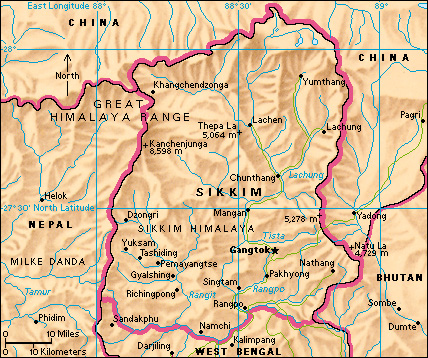Gangtok (pop. 100,286) is the capital of the Indian state of Sikkim. Sikkim became a state in 1975, but Gangtok was also the capital of Sikkim during the rule of Phuntsog Namgyal (1604-1670) and his descendants. Sikkim was governed by chogyals (kings) from the 1600’s until 1975. In the 1800’s, the British gained control of Sikkim, and in 1890, it was recognized as a British protectorate. In 1935, under the Government of India Act, Sikkim was defined as an Indian princely state. In 1975, Sikkim became a state of the Indian Union. The institution of chogyal was abolished and a governor appointed, as was the case with all Indian states.

Gangtok lies on a ridge in southeastern Sikkim and is a popular resort during the warmer months of the year. Its name means “hilltop.” It serves as a market town for the surrounding region and also a center for traditional crafts. The nearest airport and railroad are both in the state of West Bengal. The Royal Palace of the kings of Sikkim still stands in Gangtok.
Gangtok was an important stop on the trade route between India and Tibet before the border was closed in 1962. Gangtok is a Buddhist town, and there are several important Buddhist institutions in the area. The Namgyal Institute of Tibetology is located in Gangtok. It is a major center for the study of Tibetan culture and of Mahayana Buddhism. There are also several major Buddhist monasteries nearby.
